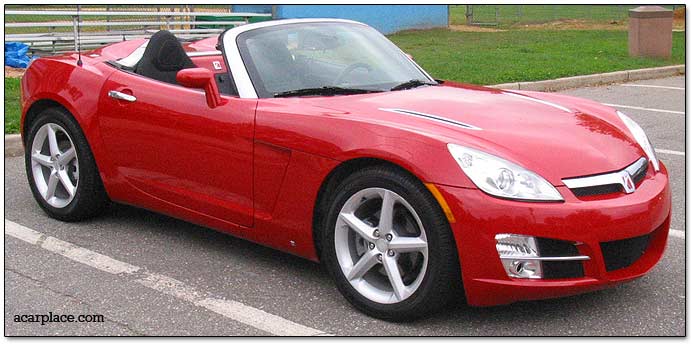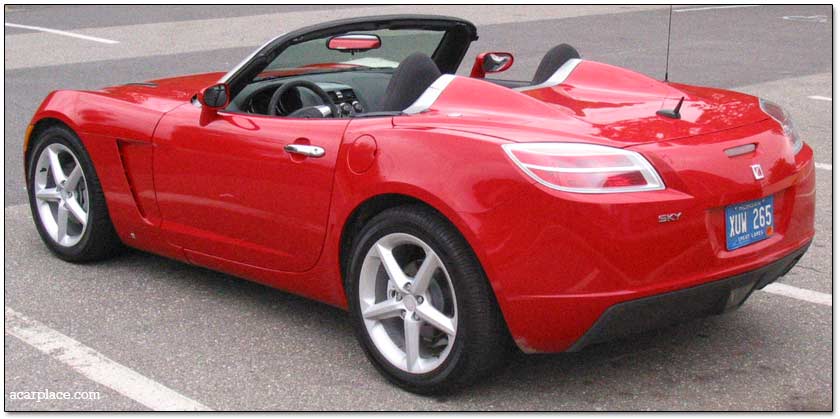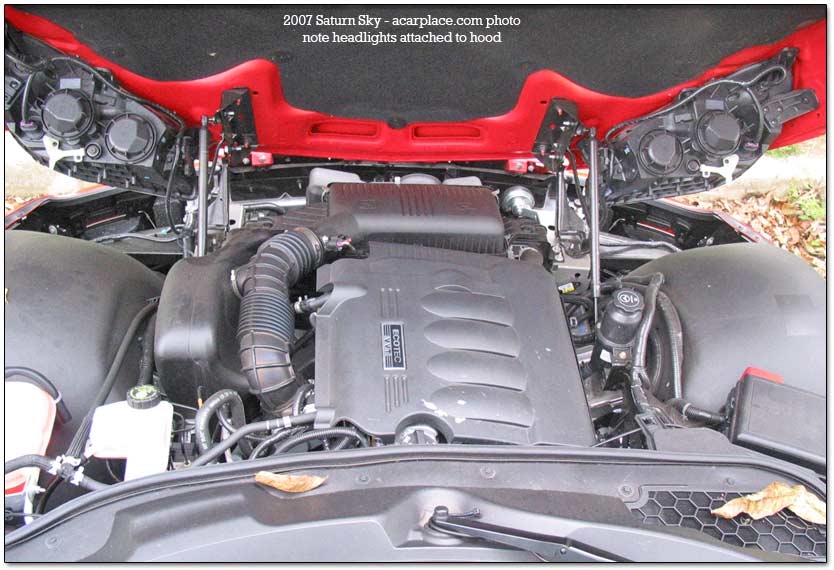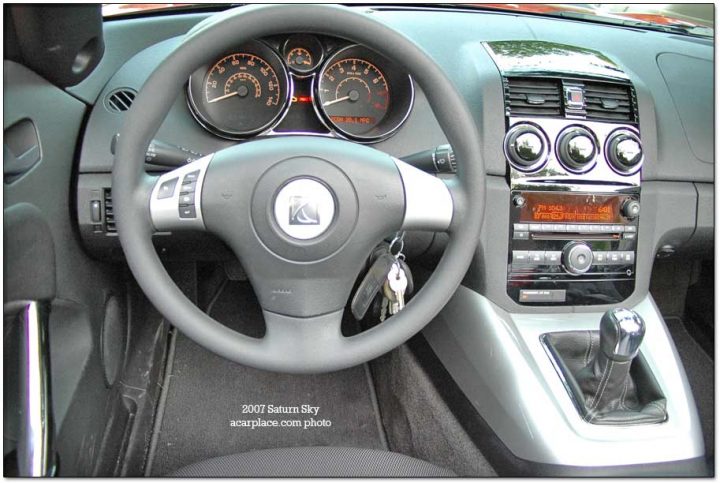
The Saturn Sky was one of the most exciting new vehicles of its time, not because of its blazing speed (it’s not all that fast), its excellent cornering and road feel, or its technology; but because it provides some of the looks of the first-generation Dodge Viper in a cute, sporty, small package. The Sky is one of those rare cars that makes heads turn – both male and female heads – and causes kids to drop what they’re doing, gape, and yell “nice car!”

Driving the Sky is an enjoyable experience even without an audience; the rubber grips the road with surprising tenacity, and you find yourself taking ever-sharper, ever-faster turns and enjoying it more. This is not one of those big heavy muscle-cars, nor one of those “toss it around” cars, but a classic British-style convertible that turns like a well designed go-kart. What’s more, the Sky manages to have one of the tightest-feeling suspensions we’ve driven without losing much comfort; bumps are well cushioned and bad roads taken in stride, without rumble or discomfort. You can feel without being punished for it.
| Review Notes: Saturn Sky | |
| Personality | British roadster without Lucas electrics |
|---|---|
| Gas Mileage | EPA estimates: 20 city, 28 highway (expect 20 city, 24 highway) |
| Unusual features | Manual convertible top; l’il Viper styling |
| Notes | Scrapes the driveway too easily; similar to Pontiac Solstice |
The engine is good for 0-60 in about 7.3 seconds, according to General Motors, but it’s more of a sprint runner than a torquer. Once you’re going, you have to drop down a gear or two to get things moving; the engine seems to be one of those modern “gotta be near redline” creatures. On the lighter side, a big heavy engine would probably take away a lot of the fun of the Sky, which performs more than adequately (provided you’re not lazy with the shifter) and emits a deep rumble at idle that matches its looks. (By the way, in case you were wondering, the “air intake vents” on the hood are solid and nonfunctional, as are the “brake cooling vents” on the front fenders, there apparently to increase the Viper resemblance.) Indeed, one could say that it’s more fun this way, with the ability to easily come up to highway speed or thwart lane-cheaters at stoplights, but without as much risk of accidentally doing a 360 because you hit the gas at the wrong time. The engine is quite enough without being too much – it’s easily controllable. Around town, the Sky never feels underpowered, but on the freeway, expect to drop down a couple of gears for passing power.

There’s supposed to be a 260 horsepower supercharged version on the way, which makes sense given the Cobalt SS and Solstice GXP. This “Red Line” version will supposedly get a torque-sensing limited-slip differential, stability control, and a stiffer suspension, as well as a boost gauge and various cosmetic changes.
We tested a manual transmission car, and were very happy with the clutch and shifter; the clutch was easy to manage, and the shifter felt heavy and mechanical, the way a sports car probably should (though it’s a matter of taste). An unusual amount of vibration was transmitted through the shifter. It was easy to pick each gear, including reverse, and we had no “oopsies.” The speed limiter kicked in well before we hit the marked redline, though.
Unlike many cars, the Sky had no noticeable torque steer even under full acceleration, and didn’t mind powered turns at all; and unlike some sports cars, it didn’t immediately lose its grip when going over bumps or dirty roads.
The Sky’s feel is very mechanical: it requires some force to shift gears, the engine vibrates clearly through the shifter, the wheel moves with more effort than on most cars, and there’s an ever-present vibration. It’s not annoying when you’re driving, but you do notice suddenly how still and well-insulated other cars are. We commend Saturn engineers for leaving the feel of the old-style roadsters in place; for they could no doubt have made it as silky-smooth as they liked. Perhaps it’s that mechanical feel and physical rumble that separates the fun to drive sports cars from those that have great paper numbers but aren’t much fun to drive (we’re looking at you, Lexus GS !) The Saturn Sky made us happy to be writing car reviews.

The convertible top is well designed for the most part; it takes about 10-20 seconds to take it off or put it on, with practice, faster than most automated setups. To take it off, you pop the trunk (from a button awkwardly placed in the glove compartment), open it, quickly rotate a handle, then just get out of the car and gently push it back into the trunk; then you can close the trunk. Unfortunately, there’s no room for any real baggage; the glove compartment is pretty much full when you get the car, leaving a small cubic storage area the size of one CD lying down and standing up inside the cabin, and another space behind the top in the trunk that isn’t much larger. There’s no spare tire, incidentally, just a patch-and-inflate kit.
Putting the top back on is similarly quick if not streamlined. Pop and open the trunk, drag the lightweight top out until it covers the car, then move the latch again; it gets easy to line up the top right the first time. Once it’s tightened, close the trunk and snap in the two side extenders. It requires a little muscle but not as much as the old Cavalier convertible top did. The only real problem with the process is the running-around part; you have to pop in and out of the car and dash around to get both sides.
With the top up, visibility is rather limited, as one might expect from a convertible; in addition to the usual massive blind spots in the rear quarters, the driver sits fairly low in the Sky, so rear view is constricted as well. With the top down, being able to see all around compensates for that. Also, with the top off, the day/night mirror is essentially useless except as a standard rearview mirror, because it depends on a black roof. The side mirrors are fairly small, which wasn’t a good design choice with the inevitable ragtop blind spots. On the lighter side, the rear window is glass and includes a standard electric defroster.
Adding to the unique look of the Sky was the reverse-opening hood and trunk. The hood goes up the exotic way, with the hinges by the bumper; the headlights go up with the hood (unfortunately stressing the headlight power lines a little). Access to the engine is pretty good at that point, though radiator replacement doesn’t look fun. Since the powerplant is a corporate GM fixture, parts should be relatively easy to get and expertise not impossible to find. The trunk opens with the push of a button from the glove compartment or key fob; instantly the two rear top latches pop out, and then you can open the lightweight moulded plastic trunk lid, again with the hinges at the bumper, so it opens like an ordinary car’s hood. Both hood and trunk stay open easily without prop rods.
Generally, the Sky is terribly enjoyable with an open top, but there were some top-off issues. First, the bright chrome between the gauges could cause a surprising amount of blinding glare when hit by the sun; and then the sun also made it impossible to read any of the displays other than speed and tachometer. And if you try to block the sun with the sun visors, forget it – they’re for show only. They don’t fold up and over the top of the windshield; they don’t extend to the corner or to the middle; and they don’t swing around to protect the driver’s side. Indeed, these are the most useless sun visors we’ve ever seen on a vehicle, and yet they found the time to install a mirror in them.
The interior is generally low-key and no-frills; our base model had but two seat adjustments, a hard-to-use crank for adjusting the recline, which, if you wanted to recline more, also meant using the second seat adjustment, the fore-aft control, because there was absolutely no room behind the seats. The seats are done in a tough no-frills black fabric, the floors in black carpet, and the dashboard was mainly black plastic, with two big round gauges for speed and tachometer (the latter in a nice old-fashioned design with oversized single digits) and a smaller one for fuel level. Engine temperature is indicated via dummy light and, if you really care, through the standard trip computer – assuming the light isn’t make the latter impossible to read.

The trip computer is worth some time, since it’s standard even on the base model, and is one of those features you expect to be optional. Controlled from steering wheel buttons, it lets you know the average gas mileage, average speed, distance to empty, outside temperature, and the exact temperature of the antifreeze. If you’re stopped, you can also set a few vehicle options like whether the doors automatically unlock, whether pressing the unlock button on the fob works on one or both doors, how long the headlights stay lit after you stop, etc. It’s a nice and useful feature. Unfortunately, GM, in their infinite wisdom, put the two control buttons right beneath the cruise control buttons (two of those, as well – no cancel button!) so you have to do a little hunting to find either one. Separating them or having more tactile differentiation would have made sense. The cruise itself works well but is a bit awkward, with a single on-off button that provides no visual indication of whether the system is on or off, and (again) no cancel button. A unique feature is the General Motors “oil life remaining” display, which uses a computer to determine when you need to change your oil; it can extend visits from every 3,000 miles all the way to over 10,000 miles, without much risk.
The climate control is set with three knobs, each self-explanatory, with a nice look and feel; the air conditioner doesn’t affect power much. The headlights are always on, this being a GM, though you can shut them off manually (each time you get in), if you don’t mind being scolded by the trip computer for it.
Some of the ergonomics of the Sky aren’t what we would want – not just the “walk around and get in and out of the car” ragtop issues, the lack of real sunshades, or the assumption that we’ll all drive the Sky on days with the sun in just the right position to see the gauges and not be blinded by reflections or have gauges (particularly gas) be made invisible by reflections or get washed out. The only small-object storage is in the glove compartment, which is too far away to comfortably use while driving, and in a cubbyhole between the seats, which is too far back to easily reach while driving. That means that if you have to put down your sunglasses, EZ-Pass, change, or other gadgets or gizmos, you need to use the passenger seat or have the passenger stow them for you. Turnpike tickets can blow away rather easily in the wind.
The seats aren’t particularly adjustable, and not everyone will fit comfortably between the side supports; the lower back bolster is rather overdone and not adjustable. What the designers did provide in a two-passenger car were three cupholders, two of which are between the seats (again, behind the driver) and one of which comes out from the center hump. Again, it’s hard to reach all the way back for the seat belt, and the window lower/raise buttons are positioned much farther back on the armrest than they should be; in my case, my arm was too long to fit and I had to get into an odd position to move the windows up and down.
The stereo is probably decent (we had the optional Monsoon model, which we suspect is not the best use of your money) but it’s hard to tell with the ambient noise of a convertible. Quite aside from the rumbly exhaust, wind noise is not really noticed when you’re driving, but it’s certainly there, along with any other noise from the outside world. The unit itself was moderately easy to use, with a clever tabbed-pushbutton interface for quick selection of AM and FM stations (favorites are mixed together to make selection faster), but again the display was easily washed out if the sun was in the wrong place.
At $23,705, it was hard to beat the price of the Saturn Sky; there aren’t many convertibles, much less specialty convertibles, in that range. For that price, you didn’t get a stripped-down beater; it included the four-wheel disc antilock brakes, theft deterrent, battery rundown protection, fog lamps, clear glass rear window with defroster, intermittent wipers, 18 inch aluminum wheels, P245/45R all-season radials, air conditioning, power locks, windows, and mirrors, remote, cruise, CD, tilt-wheel, map lights, the aforementioned trip computer, and that rarest and priciest of options, floor mats.
The Saturn Sky is one of the most fun cars we’ve ever driven. It’s not the fastest, but it feels incredibly good going around those sharp corners with no roof on. It’s probably not the best choice as a family car or a grocery getter, but it’s a lot of fun as a second car or a commuter.

David Zatz has been writing about cars and trucks since the early 1990s, including books on the Dodge Viper, classic Jeeps, and Chrysler minivans. He also writes on organizational development and business at toolpack.com and covers Mac statistics software at macstats.org. David has been quoted by the New York Times, the Daily Telegraph, the Detroit News, and USA Today.

Leave a Reply